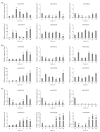Expression Analyses of Soybean VOZ Transcription Factors and the Role of GmVOZ1G in Drought and Salt Stress Tolerance
- PMID: 32245276
- PMCID: PMC7139294
- DOI: 10.3390/ijms21062177
Expression Analyses of Soybean VOZ Transcription Factors and the Role of GmVOZ1G in Drought and Salt Stress Tolerance
Abstract
Vascular plant one-zinc-finger (VOZ) transcription factor, a plant specific one-zinc-finger-type transcriptional activator, is involved in regulating numerous biological processes such as floral induction and development, defense against pathogens, and response to multiple types of abiotic stress. Six VOZ transcription factor-encoding genes (GmVOZs) have been reported to exist in the soybean (Glycine max) genome. In spite of this, little information is currently available regarding GmVOZs. In this study, GmVOZs were cloned and characterized. GmVOZ genes encode proteins possessing transcriptional activation activity in yeast cells. GmVOZ1E, GmVOZ2B, and GmVOZ2D gene products were widely dispersed in the cytosol, while GmVOZ1G was primarily located in the nucleus. GmVOZs displayed a differential expression profile under dehydration, salt, and salicylic acid (SA) stress conditions. Among them, GmVOZ1G showed a significantly induced expression in response to all stress treatments. Overexpression of GmVOZ1G in soybean hairy roots resulted in a greater tolerance to drought and salt stress. In contrast, RNA interference (RNAi) soybean hairy roots suppressing GmVOZ1G were more sensitive to both of these stresses. Under drought treatment, soybean composite plants with an overexpression of hairy roots had higher relative water content (RWC). In response to drought and salt stress, lower malondialdehyde (MDA) accumulation and higher peroxidase (POD) and superoxide dismutase (SOD) activities were observed in soybean composite seedlings with an overexpression of hairy roots. The opposite results for each physiological parameter were obtained in RNAi lines. In conclusion, GmVOZ1G positively regulates drought and salt stress tolerance in soybean hairy roots. Our results will be valuable for the functional characterization of soybean VOZ transcription factors under abiotic stress.
Keywords: VOZ transcription factor; drought and salt tolerance; expression characterization; soybean; stress response.
Conflict of interest statement
The authors declare that they have no competing interest.
Figures







Similar articles
-
Characterization of the soybean R2R3-MYB transcription factor GmMYB81 and its functional roles under abiotic stresses.Gene. 2020 Aug 30;753:144803. doi: 10.1016/j.gene.2020.144803. Epub 2020 May 21. Gene. 2020. PMID: 32446917
-
Characterization of Vascular plant One-Zinc finger (VOZ) in soybean (Glycine max and Glycine soja) and their expression analyses under drought condition.PLoS One. 2021 Jul 2;16(7):e0253836. doi: 10.1371/journal.pone.0253836. eCollection 2021. PLoS One. 2021. Retraction in: PLoS One. 2023 Apr 19;18(4):e0283917. doi: 10.1371/journal.pone.0283917. PMID: 34214130 Free PMC article. Retracted.
-
Genome-Wide Analysis of the Soybean Calmodulin-Binding Protein 60 Family and Identification of GmCBP60A-1 Responses to Drought and Salt Stresses.Int J Mol Sci. 2021 Dec 16;22(24):13501. doi: 10.3390/ijms222413501. Int J Mol Sci. 2021. PMID: 34948302 Free PMC article.
-
Overexpression of an aquaporin protein from Aspergillus glaucus confers salt tolerance in transgenic soybean.Transgenic Res. 2021 Dec;30(6):727-737. doi: 10.1007/s11248-021-00280-9. Epub 2021 Aug 30. Transgenic Res. 2021. PMID: 34460070 Review.
-
EARLY RESPONSIVE to DEHYDRATION 15, a new transcription factor that integrates stress signaling pathways.Plant Signal Behav. 2011 Dec;6(12):1993-6. doi: 10.4161/psb.6.12.18268. Plant Signal Behav. 2011. PMID: 22105026 Free PMC article. Review.
Cited by
-
Identification of Known and Novel Arundo donax L. MicroRNAs and Their Targets Using High-Throughput Sequencing and Degradome Analysis.Life (Basel). 2022 Apr 27;12(5):651. doi: 10.3390/life12050651. Life (Basel). 2022. PMID: 35629319 Free PMC article.
-
H2O2-dependent oxidation of the transcription factor GmNTL1 promotes salt tolerance in soybean.Plant Cell. 2023 Dec 21;36(1):112-135. doi: 10.1093/plcell/koad250. Plant Cell. 2023. PMID: 37770034 Free PMC article.
-
Genome-Wide Identification of Vascular Plant One-Zinc-Finger Gene Family in Six Cucurbitaceae Species and the Role of CmoVOZ2 in Salt and Drought Stress Tolerance.Genes (Basel). 2024 Feb 27;15(3):307. doi: 10.3390/genes15030307. Genes (Basel). 2024. PMID: 38540365 Free PMC article.
-
Genome-wide identification of VOZ gene family in ten cotton species and the function analysis of GhVOZ2 involved in heat stress response.BMC Genomics. 2025 Aug 18;26(1):753. doi: 10.1186/s12864-025-11957-4. BMC Genomics. 2025. PMID: 40826317 Free PMC article.
-
Unfolding molecular switches for salt stress resilience in soybean: recent advances and prospects for salt-tolerant smart plant production.Front Plant Sci. 2023 Apr 19;14:1162014. doi: 10.3389/fpls.2023.1162014. eCollection 2023. Front Plant Sci. 2023. PMID: 37152141 Free PMC article. Review.
References
MeSH terms
Substances
Grants and funding
LinkOut - more resources
Full Text Sources
Medical

